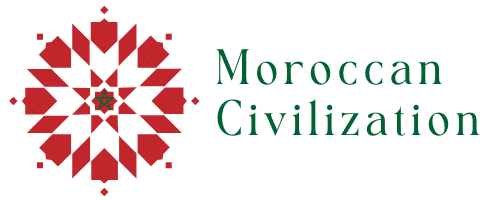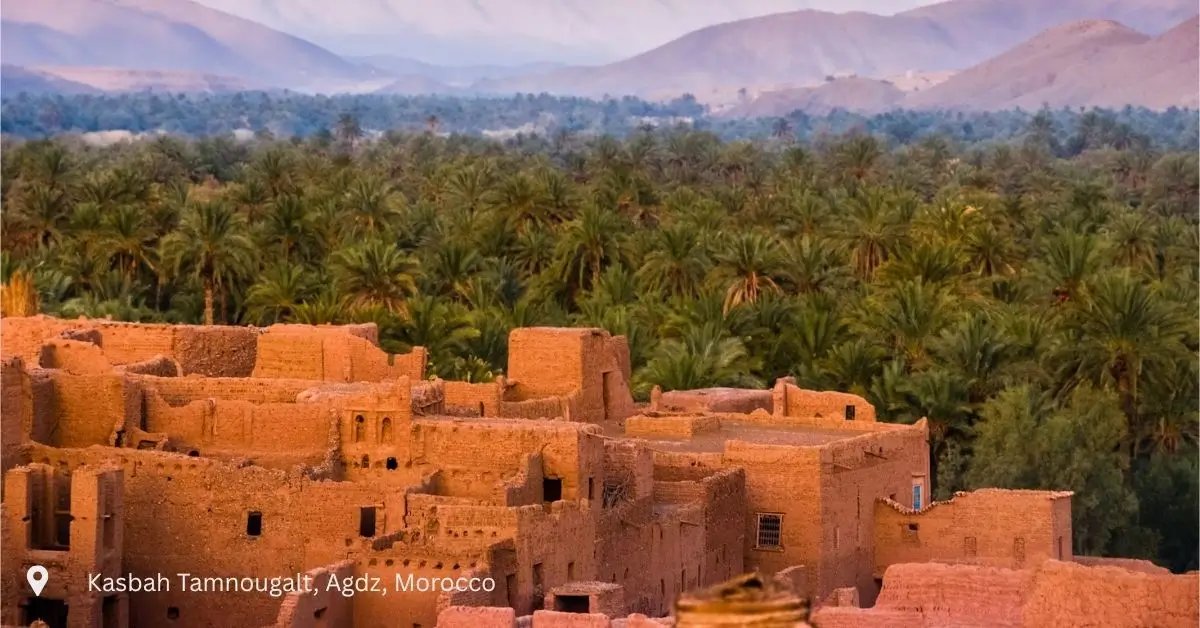Kasbah Tamnougalt 7 Reasons This Hidden Gem Captivates Morocco Lovers
When I arrived at Kasbah Tamnougalt, something shifted. Raised in bustling Casablanca but rooted in the traditions of Taounate, I felt both parts of myself come alive in its earthen corridors. This ancient kasbah, set against the palms of the Draa Valley, isn’t just a monument — it’s a memory.
Table of Contents
A place where Amazigh, Arab, and Jewish lives once flowed together. Unlike restored kasbahs, Kasbah Tamnougalt remains a living archive. From its maze-like paths to the carved wood of the Caid’s house, everything whispers stories. If you’re searching for Morocco’s soul, you’ll find it here, waiting under sun-baked walls.
My Roots in Clay and Memory A Journey to Kasbah Tamnougalt
How I Found My Way to Kasbah Tamnougalt
When I first stepped into Kasbah Tamnougalt, I wasn’t just a traveler — I was returning to something deep inside me. Raised between the waves of Casablanca and the olive groves of Taounate, I’ve always lived in two worlds. But it was in the shadows and sunlit alleys of this kasbah that I felt them merge. The earth here smells like memory. The walls seem to breathe. You walk through centuries. And somehow, it feels like the kasbah has been waiting for you — holding your place in its story.
I remember sitting under a carved wooden lintel, sipping mint tea with an old Amazigh guardian who spoke of his Jewish neighbors like they had just stepped out for bread. “We lived side by side,” he said, “before time started running too fast.” That moment stayed with me. Tamnougalt is not a ruin — it’s a witness. A place where Muslims and Jews prayed under the same stars, where caravans from Timbuktu and Marrakech crossed paths in the dust, and where stories echo in the wind if you know how to listen.
Why Kasbah Tamnougalt Isn’t Just Another Site
Kasbah Tamnougalt isn’t flashy. It doesn’t shout. But it holds something rare — authenticity. Unlike many kasbahs turned museums or hotels, Tamnougalt still hums with village life. Children laugh between crumbling archways. Women carry bread in clay ovens. The kasbah rises above the Draa palm grove like a sandcastle frozen mid-prayer. As I wrote in our Land of 1000 Kasbahs guide, this place doesn’t just tell history — it lives it.
Whether you’re drawn by history, architecture, or just that unexplainable feeling of being somewhere real, Kasbah Tamnougalt offers a rare kind of Moroccan beauty. One that’s quiet, rooted, and unforgettable.
Uncovering the Past – The History and Architecture of Kasbah Tamnougalt
From Caravan Crossroads to Cultural Beacon
Long before guidebooks and cameras arrived, Kasbah Tamnougalt stood as the pulse of the Draa Valley. Its name — Tamnougalt — means “meeting place” in Amazigh, and that’s exactly what it was. This was no isolated fortress; it was the heart of a powerful ksar, once the capital of the Mezguita tribe. Merchants, mystics, and messengers passed through here, bound for Timbuktu or Marrakech, trading salt, gold, and stories.
Built in the 16th century, the kasbah served both strategic and spiritual roles. It guarded the Draa’s lifeblood — its water and palm groves — while acting as a bridge between desert and mountain cultures. As I wrote in our Morocco Cities Guide, places like this weren’t just walls and gates. They were crossroads of civilization, and Tamnougalt was among the most respected.
The Architecture That Speaks Without Words
The first thing you’ll notice in Kasbah Tamnougalt is how the light dances differently here. The ochre walls are built from rammed earth (pisé), and their texture catches the sun like fabric. Walk through its narrow corridors and you’ll pass under arches that feel more sculpted than built. Covered passageways snake like veins through the kasbah, leading to hidden courtyards, olive oil cellars, and the Caid’s residence — complete with a hammam.
The layout is classic Berber architecture: defensive but beautiful. Everything has purpose — high walls to reflect heat, tiny windows to reduce glare, stairs that curve to confuse invaders. Even today, the kasbah’s skyline seems to rise and fold like sand dunes, perfectly in rhythm with the desert beyond.
And yet, it’s more than design. It’s intention. This was architecture made not just for protection, but for poetry. In Tamnougalt, form follows faith — and both follow the land.
A Shared Legacy – The Jewish Presence in Kasbah Tamnougalt
Jewish Roots in the Draa Valley
Many travelers pass through Kasbah Tamnougalt without knowing one of its most tender truths: it once held a thriving Jewish community. Long before borders hardened or politics divided, Jewish and Amazigh families lived here — not just side by side, but together. They worked the land, shared feasts, debated under stars, and protected one another. In the kasbah’s faded alleyways, you’ll still find traces: a Star of David etched in plaster, the layout of old quarters, or a silent corner where a mezuzah once hung.
In a place where Muslims fasted during Ramadan and Jews observed Shabbat, community wasn’t a matter of tolerance — it was a matter of life. Tamnougalt reminds us that Morocco’s heart is not built on uniformity, but on the richness of coexistence.
I remember a craftsman I met near the Caid’s house. He ran his fingers along a wooden beam and said, “The hands that built this were not all the same faith. But they had the same dust on them.” That’s Morocco. And that’s the kasbah spirit I try to preserve in Moroccan Civilization.
Festivals, Faith, and the Spirit of Baraka
Tamnougalt is also known for hosting the Moussem Ellama — a spiritual festival celebrating scholars, peace, and blessings. Though its form has changed, its roots are interfaith. Jews and Muslims once gathered under the same palm trees for this event, exchanging dates, songs, and prayers.
That shared reverence is part of what gives Kasbah Tamnougalt its quiet power. It isn’t just old — it’s wise. It remembers. And it welcomes.
Living Heritage – Daily Life in and Around Kasbah Tamnougalt
Not Just Ruins – A Village That Breathes
Step into Kasbah Tamnougalt and you won’t find velvet ropes or glossy placards. You’ll find people. Grandmothers tending gardens, children racing through sunlit alleys, young men weaving palm baskets, women carrying loaves to clay ovens. This kasbah isn’t frozen in time — it’s beating with it. That’s what moved me most. Here, history isn’t something you look at. It’s something you share tea with.
One morning, I wandered into a courtyard and met an elder named Moulay Hassan. He spoke softly, “We’re not caretakers of ruins — we’re guardians of memory.” His family has lived in Tamnougalt for generations. They remember the floods, the droughts, the marriages under olive trees, and the days when Jews and Amazighs danced to the same flute. He showed me his son’s rooftop garden — tomatoes, mint, and a single fig tree pushing against the sky. “The kasbah gives,” he smiled. “You just have to listen.”
This rhythm of life is what makes Tamnougalt so rare. It hasn’t been emptied or commercialized. Instead, it has been lived into.
Craft, Community, and Everyday Beauty
From the hammam to the date markets, from the prayer calls to the weaving circles — daily life here flows with a sense of continuity. The local artisans still shape mud bricks by hand, using techniques that predate modern cement. Every surface tells a story. Every crack holds a song.
Experience the Magic – What to See and Do in Kasbah Tamnougalt
Explore the Maze, Touch the Past
Visiting Kasbah Tamnougalt is like walking into a clay dream that hasn’t ended yet. Start with the main gate, where the ochre walls rise like guardians of the valley. A local guide — often a resident of the ksar — can walk you through corridors that twist like memory, through courtyards where the sun paints patterns on the walls, and into the Caid’s old office, where history once made its decisions. Don’t miss the hammam, a rare example of community wellness design that has stood for centuries.
Climb to the rooftop terraces. From there, the view stretches across the Draa Valley’s endless palmgroves, kissed by the Atlas in the distance. At sunrise or sunset, it feels like the kasbah and the sky are in prayer together.
Nearby Gems and Desert Gateways
Tamnougalt is just a few kilometers from Agdz, a town that feels like a gentle handshake before the desert begins. Agdz itself has charming cafés, lively markets, and access to hiking trails that wind through hidden oases and riverbeds. Many travelers use it as a base before heading deeper into the Sahara, making Kasbah Tamnougalt the perfect place to pause, reflect, and ground your journey.
For film lovers, you’ll be walking on cinematic ground. Tamnougalt has appeared in Prince of Persia, The Mummy, and Babel. But no camera captures its stillness, its silence, its soul. Only your footsteps can do that.
Want help planning the full route? Download our handcrafted Explore Morocco in 15 Days itinerary — it includes stops like Tamnougalt, plus local secrets the big travel blogs never mention.
And if you’re flying in soon, check updated options in our Flights to Morocco travel hub.
The Soul of the South – Why Kasbah Tamnougalt Matters More Than Ever
A Mirror to Morocco’s Real Identity
In today’s rush toward modernity, places like Kasbah Tamnougalt remind us who we are — not just as Moroccans, but as human beings. This isn’t just another tourist site. It’s a keeper of wisdom. A place that shows how beauty can be made from mud, straw, and faith. Where Amazigh farmers and Jewish traders built together. Where the call to prayer once mingled with Hebrew songs. Where the desert didn’t divide people — it connected them.
Standing in Tamnougalt, I realized that this kasbah isn’t clinging to the past. It’s inviting us to bring the past forward — to remember a time when community meant more than borders or belief.
That’s the Morocco I want the world to know. Not just the photos of dunes and spices. But the kasbahs of the south — places like Tamnougalt — where life still whispers, “You belong.”
Why We Must Protect Places Like Tamnougalt
But make no mistake — this heritage is fragile. Without care, these walls could fall silent. That’s why projects like Moroccan Civilization matter. We’re not just storytellers — we’re bridge-builders. Every traveler who walks through Kasbah Tamnougalt, every artisan supported, every forgotten song remembered — that’s an act of preservation.
Want to support this living heritage? Book with guides who live here. Buy crafts from women’s cooperatives. Share the story, but do it with love and respect. Tamnougalt isn’t just a “place to see” — it’s a place to feel, protect, and pass on.
Start your journey by exploring our full Land of 1000 Kasbahs guide, or reach out directly via our Contact page for personalized tips and connections.
Kasbah Tamnougalt – A Living Heart in the Draa Valley
Kasbah Tamnougalt is not the most famous kasbah in Morocco — and that’s its power. It hasn’t been polished for postcards. It remains wild, weathered, and real. It holds the breath of desert winds, the footsteps of forgotten pilgrims, the laughter of children who still call its alleys home.
When I walked through its earthen corridors, I didn’t feel like a tourist. I felt like a witness — and perhaps, a messenger. Because places like this don’t ask to be admired. They ask to be remembered.
If you come here, come with humility. Come ready to listen. And if you leave changed — as I did — let that be your gift back to this kasbah and all it represents.

